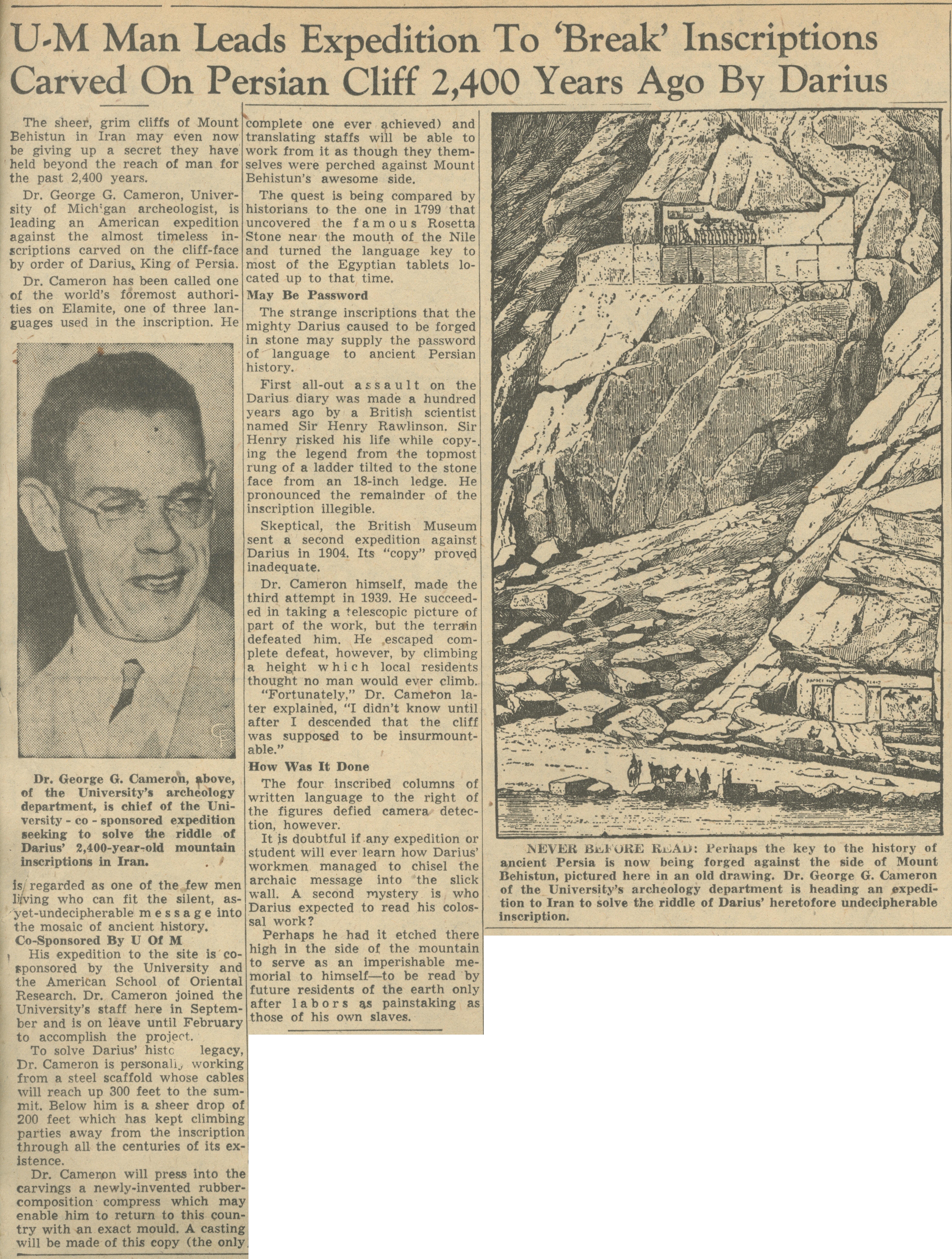U-M Man Leads Expedition To 'Break' Inscriptions Carved On Persian Cliff 2,400 Years Ago By Darius

The sheer, grim cliffs of Mount Behistun in Iran may even now be giving up a secret they have held beyond the reach of man for the past 2,400 years.
Dr. George G. Cameron, University of Michigan archaeologist, is leading an American expedition against the almost timeless inscriptions carved on the cliff-face by order of Darius, King of Persia.
Dr. Cameron has been called one of the world’s foremost authorities on Elamite, one of three languages used in the inscription. He is regarded as one of the few men living who can fit the silent, as-yet-undecipherable message into the mosaic of ancient history.
Co-Sponsored by U Of M
His expedition to the site is co-sponsored by the University and the American School of Oriental Research. Dr. Cameron joined the University’s staff here in September and is on leave until February to accomplish the project.
To solve Darius’ historic legacy, Dr. Cameron is personally working from a steel scaffold whose cables will reach up 300 feet to the summit. Below him is a sheer drop of 200 feet which has kept climbing parties away from the inscription through all the centuries of its existence.
Dr. Cameron will press into the carvings a newly-invented rubber-composition compress which may enable him to return to this country with an exact mould. A casting will be made of this copy (the only complete one ever achieved) and translating staffs will be able to work from it as though they themselves were perched against Mount Behistun’s awesome side.
The quest is being compared by historians to the one in 1799 that uncovered the famous Rosetta Stone near the mouth of the Nile and turned the language key to most of the Egyptian tablets located up to that time.
May Be Password
The strange inscriptions that the mighty Darius caused to be forged in stone may supply the password of language to ancient Persian history.
First all-out assault on the Darius diary was made a hundred years ago by a British scientist named Sir Henry Rawlinson. Sir Henry risked his life while copying the legend from the topmost rung of a ladder tilted to the stone face from an 18-inch ledge. He pronounced the remainder of the inscription illegible.
Skeptical, the British Museum sent a second expedition against Darius in 1904. Its “copy” proved inadequate.
Dr. Cameron himself, made the third attempt in 1939. He succeeded in taking a telescopic picture of part of the work, but the terrain defeated him. He escaped complete defeat, however, by climbing a height which local residents thought no man would ever climb.
“Fortunately,” Dr. Cameron later explained, “I didn’t know until after I descended that the cliff was supposed to be insurmountable.”
How Was It Done
The four inscribed columns of written language to the right of the figures defied camera detection, however.
It is doubtful if any expedition or student will ever learn how Darius’ workmen managed to chisel the archaic message into the slick wall. A second mystery is who Darius expected to read his colossal work?
Perhaps he had it etched there high in the side of the mountain to serve as an imperishable memorial to himself—to be read by future residents of the earth only after labors as painstaking as those of his own slaves.
IMAGE TEXTS:
Dr. George G. Cameron, above, of the University’s archaeology department, is chief of the University-co-sponsored expedition seeking to solve the riddle of Darius’ 2,400-year-old mountain inscriptions in Iran.
Never Before Read: Perhaps the key to the history of ancient Persia is now being forged against the side of Mount Behistun, pictured here in an old drawing. Dr. George G. Cameron of the University’s archaeology department is heading an expedition to Iran to solve the riddle of Darius’ heretofore undecipherable inscription.